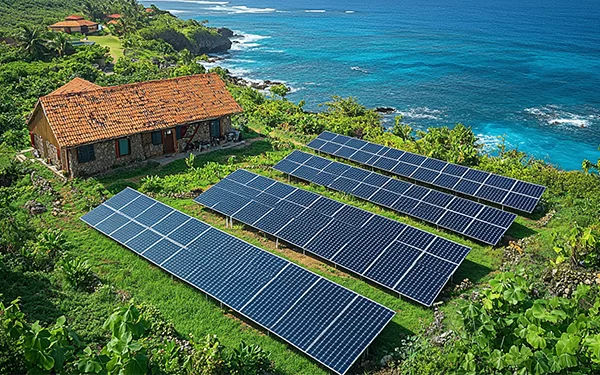Case Analysis of Solar Microgrid Design: A Microgrid Project for a Stationed Island
Project Background
A microgrid is a flexible and independently operable distribution system, particularly suitable for power supply in remote areas and islands. Due to the inability of traditional diesel generation to meet the growing electricity demand on a stationed island, the project opted for a mixed power generation system primarily based on wind and solar energy, supplemented by diesel generators and an energy storage system. This system not only improves generation efficiency but also reduces operational costs, aiding the island in achieving energy self-sufficiency.
Overall Construction Plan for Solar Microgrid Design
The design of this project has a total load capacity of no less than 10 kWh, with specific power generation methods including:
– Photovoltaic Power Generation System: Installation of two sets of 50 kWp photovoltaic systems, covering an area of approximately 1,000 square meters.
– Wind Power Generation System: Deployment of 6 units of 5 kW small wind turbines, with a total capacity of 30 kW.
– Diesel Power Generation System: A 30 kW diesel generator is configured as a backup power source.
– Energy Storage System: Installation of a 100 kW PCS and a 600 kWh lithium iron phosphate energy storage system to ensure continuous power supply.
Solar Microgrid Design System Components
– Photovoltaic Power Generation System
– Component Tilt Angle Design: The tilt angle is set at 15 degrees based on local sunlight conditions to maximize light reception.
– Lightning Protection Measures: Multi-level lightning protection devices are employed to ensure system safety.
– Construction Design: Utilizing the open terrain, a dispersed layout of photovoltaic arrays is adopted, with a construction period of approximately 3 months.
– Wind Power Generation System
– Turbine Selection: 5 kW small wind turbine units with a startup wind speed of 2.5 m/s are selected.
– System Composition: Comprising wind turbines, generators, grid controllers, inverters, and isolation transformers.
– Energy Storage System
– Design Principles: The system is designed to improve the quality of wind energy access and ensure continuous power supply for critical loads during island operation.
– System Composition: A 100 kW/600 kWh lithium iron phosphate battery module is used, supporting both remote and local control.
Microgrid Control Management Center Design
This center integrates an intelligent power supply system that combines wind, solar, diesel, and storage, achieving efficient and safe operation through real-time scheduling and control. The system can monitor power generation, energy storage status, and electricity usage in real time, making timely adjustments to ensure system stability.
Key Technical Parameters
– Photovoltaic System: Total capacity of 100 kWp, using monocrystalline silicon photovoltaic modules.
– Wind Power Generation System: Total capacity of 30 kW, deployed in areas rich in wind resources on the island.
– Diesel Generator: Output power of 30 kW, serving as a cold backup power source.
– Energy Storage System: 600 kWh, using lithium iron phosphate batteries to ensure power supply capability under extreme weather conditions.
Advantages and Challenges
This island microgrid project demonstrates several advantages of a mixed power generation system that combines wind and solar energy, including:
– Increased Generation Efficiency: By optimizing configurations, renewable energy usage is maximized, reducing reliance on diesel.
– Reduced Operating Costs: Over the long term, it lowers fuel and maintenance costs.
– Enhanced Power Supply Safety: The ability to operate independently ensures stable power supply during grid failures or extreme weather conditions.
However, challenges remain in the design and implementation of the solar microgrid, such as the charging speed of the energy storage system and the stability of the system under extreme weather, which require ongoing technological optimization and management strategies to address.
Through this solar microgrid design project, we see the potential for solar microgrids in island regions. The comprehensive utilization of wind and solar energy not only effectively addresses power issues on islands but also provides a reference for future energy solutions in similar areas. Achieving sustainable development and environmental protection goals while promoting the popularization of green energy will be an important direction for microgrid development.

